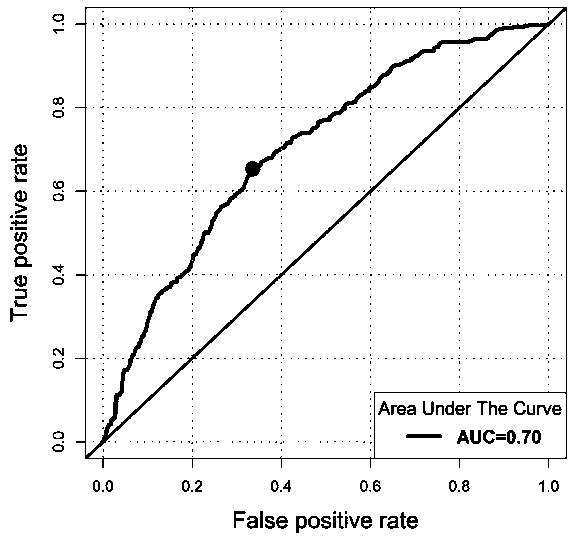An SNP marker located in a DISC1FP1 gene and related to radiation induced brain injuries caused by radiotherapy and applications thereof
A radioactive brain injury and gene technology, applied in the fields of genetic engineering and oncology, can solve problems that have not been reported
- Summary
- Abstract
- Description
- Claims
- Application Information
AI Technical Summary
Problems solved by technology
Method used
Image
Examples
Embodiment 1
[0096] Example 1 Screening of SNP markers
[0097] 1. Collection of samples and collation of data
[0098] From 2002 to 2010, a large number of blood samples were collected from the Sun Yat-Sen University Cancer Hospital Biobank. After sorting out the sample information, 2942 samples that met the following criteria were selected for genome-wide microarray scanning and single SNP Taqman genotyping:
[0099] Inclusion criteria:
[0100] (1) Nasopharyngeal carcinoma patients with clear pathological diagnosis and clinical stage;
[0101] (2) The expected survival is greater than 6 months;
[0102] (3) Functional status score (KPS) ≥ 70 points;
[0103] (4) Age 18-80 years old;
[0104] (5) Have complete medical records (medical history, physical examination, related examinations, previous treatments);
[0105] (6) Complete radiation therapy and conduct regular MR image review;
[0106] (7) Participate voluntarily and sign the informed consent form.
[0107] At the same time, ...
Embodiment 2
[0131] Example 2 TaqMan (Applied Biosystems) genotyping detection of a single SNP
[0132] The site rs10501719 associated with radiation brain injury found in Example 1 through genome-wide scanning was detected in two verification populations, including 1119 and 741 patients with nasopharyngeal carcinoma, including 177 patients with radiation brain injury cases and 261 cases. These samples were tested by Taqman genotyping.
[0133] 1. The specific steps are:
[0134] (1) Collect 3 mL of peripheral venous blood with an EDTA anticoagulant tube, centrifuge at 3500 r / min for 10 minutes, and then aspirate the plasma.
[0135] (2) Remove red blood cells: add an equal volume of red blood cell lysate (10 mmol / L TrispH7.6; 5 mmol / L MgCl 2 ; 10 mmol / L NaCl), mix well by inverting up and down, centrifuge at 4000r / min for 10 minutes, and discard the supernatant. Then add 5 mL of erythrocyte lysate, mix well by inverting up and down, centrifuge at 4000r / min for 10 minutes, and discard ...
Embodiment 3
[0158] Example 3 Kit for Predicting the Risk of Radiation Brain Injury Caused by Tumor Radiotherapy
[0159] The production and operation process of the kit for predicting the risk of radiation-induced brain injury caused by tumor radiotherapy is based on the Taqman (Applied Biosystems) genotyping detection technology.
[0160] 1. The kit contains a pair of SNP-specific amplification primers (the nucleotide sequence of the rs10501719-specific amplification primer is shown in SEQ ID No: 1-2), and a specific probe (the rs10501719-specific probe’s Nucleotide sequence such as SEQID No: 3-4). It also includes common reagents required by the corresponding PCR technology, such as: dNTP Mixture, MgCl 2 , double distilled water, reaction enzyme, reaction buffer; in addition, it also contains labeling products and controls (standard products and blank controls for genotype determination).
[0161] See Table 3 for specific primers and specific probe information.
[0162] Table 3. SNP-...
PUM
 Login to View More
Login to View More Abstract
Description
Claims
Application Information
 Login to View More
Login to View More - R&D
- Intellectual Property
- Life Sciences
- Materials
- Tech Scout
- Unparalleled Data Quality
- Higher Quality Content
- 60% Fewer Hallucinations
Browse by: Latest US Patents, China's latest patents, Technical Efficacy Thesaurus, Application Domain, Technology Topic, Popular Technical Reports.
© 2025 PatSnap. All rights reserved.Legal|Privacy policy|Modern Slavery Act Transparency Statement|Sitemap|About US| Contact US: help@patsnap.com



